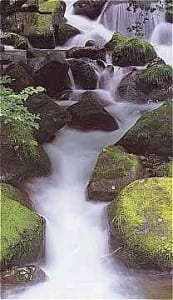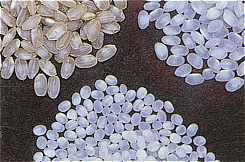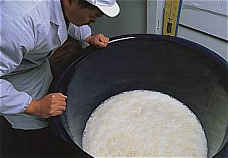Note to readers: Just a few days after this newsletter was sent out, the government finished its open hearing, and it became official: Yamagata Sake has been granted bona fide Geographical Indication, the first entire prefecture to do that in the sake world. Congratulations to them!
The Sake of Yamagata Prefecture
…and its move toward bona fide Geographical Indication
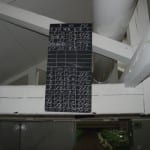 Several years ago, in July of 2014, the Yamagata Prefecture Sake Brewers’ Association began the process of securing a designation of their sake as a Geographical Indication recognized by the World Trade Organization and various international treaties. In order to qualify for something like this, a product (any product applying for a GI) must possess qualities or a reputation that are due to that origin. Securing such a designation gives the region and its producers the exclusive right to an appropriate indication on the label.
Several years ago, in July of 2014, the Yamagata Prefecture Sake Brewers’ Association began the process of securing a designation of their sake as a Geographical Indication recognized by the World Trade Organization and various international treaties. In order to qualify for something like this, a product (any product applying for a GI) must possess qualities or a reputation that are due to that origin. Securing such a designation gives the region and its producers the exclusive right to an appropriate indication on the label.
Japan’s National Tax Administration (“NTA”), the branch of the government overseeing sake, opened a 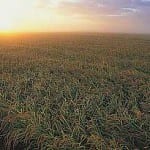 public hearing on the topic on October 19 of this year. It was not made clear how long this stage will take, but assuming it does pass smoothly, Yamagata Sake will come into existence as a bona fide Geographical Indication (GI) for sake. One more region in Japan, the city of Hakusan in Ishikawa Prefecture, has qualified for a GI for the sake of that region. However, it only applies to the five breweries in city of Hakusan; the rest of the breweries in Ishikawa Prefecture are unaffected. Yamagata Prefecture will be the first entire prefecture to secure this distinction.
public hearing on the topic on October 19 of this year. It was not made clear how long this stage will take, but assuming it does pass smoothly, Yamagata Sake will come into existence as a bona fide Geographical Indication (GI) for sake. One more region in Japan, the city of Hakusan in Ishikawa Prefecture, has qualified for a GI for the sake of that region. However, it only applies to the five breweries in city of Hakusan; the rest of the breweries in Ishikawa Prefecture are unaffected. Yamagata Prefecture will be the first entire prefecture to secure this distinction.
This will follow the NTA’s designation of “Japanese Sake” and “Nihonshu” for sake brewed in Japan, which were recognized December 25, 2015. In total, there are currently seven alcoholic beverage GI designations in Japan, other five applying to wine or shochu. Yamagata would be the eighth.
Once complete, the Yamagata Brewers’ Association will oversee things, and indications are that they will create a graphic image indicating the Yamagata GI for use by the 51 brewers in the prefecture.
Here is a bit more about the sake of this great region.
Yamagata prefecture lies packaged at a somewhat awkward angle in the lower left-hand corner of the Tohoku region. Surrounded by mountains but with a stretch open to the Japan Sea, it looks like it was designed specifically to absorb the cold and snow.
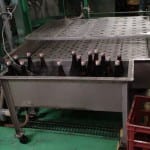 There are at present 51 sakagura brewing in Yamagata. The oldest of these dates back to the Japanese “Warring States” era of long civil war, while the youngest can trace their roots to the beginning of the Edo period. Even the new kid in town is an old and dignified character.
There are at present 51 sakagura brewing in Yamagata. The oldest of these dates back to the Japanese “Warring States” era of long civil war, while the youngest can trace their roots to the beginning of the Edo period. Even the new kid in town is an old and dignified character.
Most of these are smallish, traditional kura. While there are a couple of large-ish brewres, automation and computers, for all their cons, pros, advocates and foes in the brewing world, are certainly not unheard of up here, but they seem to be the exception and not the rule.
Those mountains and that big pond seem to have kept things all in the family for a good number of centuries. A great deal of the sake consumed in Yamagata is made there, and a comparatively small amount of what is brewed there leaves the prefecture, oh pity of pities.
To the southwest lies Niigata in all its brewing glory, and not too far to the northeast sits Iwate. Both prefectures are the home of a “toji ryuha,” or guild of master brewers, known as the Echigo Toji and Nanbu Toji respectively.
Despite this proximity to easily accessible experience, Yamagata has long handled things by themselves. In other words, the master brewer at most of the kura inYamagata are not from the major guilds in the nearby regions, but rather were “raised” inside the prefecture.
There is great cooperation amongst the kura in Yamagata with respect to education and training of these “home-grown toji.” In an interesting contrast to the sake-brewing sphere of most prefectures, ninety percent of the “kurabito” (brewery workers) are indigenous Yamagata locals. This spares them the long winters far from home historically so common among the brewing staff of the sake industry. Furthermore, there are a great number of kura not even adhering to the semi-feudal toji system.
The climate is ideal (read: cold and snowy) for brewing. Sake-slaying bacteria don’t exactly thrive at these temperatures. What does thrive, however, are several strains of wonderful sake rice that almost seems to challenge and sneer at the harshly cold weather. Much of the sake brewed here is made with such fine sake rice strains. These include Miyama Nishiki, Kame no O, Dewa Sansan, Dewa no Sato, and a handful of other Yamagata-only sake rice types as well.
The type of sake found here is in general relatively light and clean, often (but not always) with a good sturdy acid presence. But perhaps more than any other prefecture, much of the sake here seems to have an abundance of personal character and individuality. There seems to be plenty of uniquely distinct yet almost magically balanced sake. Having said that, the term that the prefecture promoted and that the NTA embraced in defining the qualities associated with the sake of the region was やわらかくて透明感のある酒質, yawarakakute tomeikan no aru shushitsu, or “sake with softness and clarity.”
The Brewers’ Association web page, found here and only in Japanese, refers to the region as “Ginjo Okoku,” or “The Empire of Ginjo-shu,” alluding to the extremely high ratio of sake brewed there that is ginjo-shu, especially when compared to that of other prefectures.
On the whole, the prefecture is active in continuing to improve their skills and the quality of their product. There are several strains of Yamagata-only yeast, as well as a special strain of koji developed in the region as well.
All of this combines to make Yamagata Prefecture a leader amongst the six prefectures of the Tohoku region, the northeastern part of Japan that has garnered great attention in the sake world over the last decade or so.
The granting of Yamagata Sake as a bona fide GI will certainly further the region’s efforts to convey to the rest of the world just how good their sake is.
~~~~~~~~~~~~~~~~~~~~~~~~~~~~~~~~~~~~~~~~~~~~~~~~
Sake Professional Course in San Francisco, April 3 ~ 5, 2017
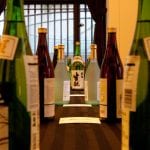 From Monday, April 3 until Wednesday April 5, I will hold the first Sake Professional Course of 2017 at Bentley Reserve in San Francisco. If interested, for more information please send me an email at sakeguy@gol.com.
From Monday, April 3 until Wednesday April 5, I will hold the first Sake Professional Course of 2017 at Bentley Reserve in San Francisco. If interested, for more information please send me an email at sakeguy@gol.com.





 Sake is booming; it is growing strongly in popularity both inside Japan and around the world. And while this is true, we still have a long way to go. In an effort to curb I.S.E. (irrational sake exuberance), here are some sobering statistics that will encourage us to drink more sake and to promote it actively.
Sake is booming; it is growing strongly in popularity both inside Japan and around the world. And while this is true, we still have a long way to go. In an effort to curb I.S.E. (irrational sake exuberance), here are some sobering statistics that will encourage us to drink more sake and to promote it actively. Only 3.2 percent of all sake made is exported
Only 3.2 percent of all sake made is exported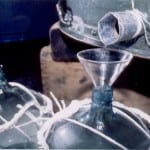 Sixty percent of all sake breweries are small to mid-sized companies, of which half are either losing money or barely (i.e. insignificantly) profitable.
Sixty percent of all sake breweries are small to mid-sized companies, of which half are either losing money or barely (i.e. insignificantly) profitable.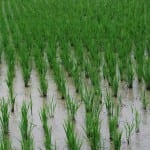 A quarter of a million tons. The fact that only thirty six percent was proper sake rice is not disconcerting at all, since so much non premium sake is made – it is still 65 percent of the market. So the numbers are just about right, even if a bit inconceivably large in scale.
A quarter of a million tons. The fact that only thirty six percent was proper sake rice is not disconcerting at all, since so much non premium sake is made – it is still 65 percent of the market. So the numbers are just about right, even if a bit inconceivably large in scale.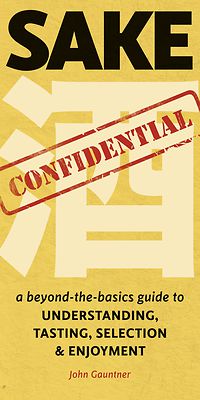
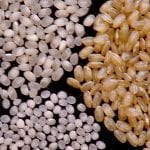 Sake is, as we all know, brewed from rice. Rice, in turn, is a very focused expression of soil, climate, and each year’s weather conditions such as sunshine, rain and typhoons. Every growing season is different, and there are good years for sake rice and bad years for sake rice.
Sake is, as we all know, brewed from rice. Rice, in turn, is a very focused expression of soil, climate, and each year’s weather conditions such as sunshine, rain and typhoons. Every growing season is different, and there are good years for sake rice and bad years for sake rice.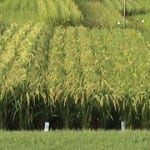 Wouldn’t it be great if someone analyzed it for them? Sure, brewers might know the weather of their immediate vicinity. But since rice can be brought in from other regions, wouldn’t it be great if the brewers could learn what to expect from each season’s rice, each of the main varieties of rice, from each region of Japan? Then they could use such data to determine how to tweak their brewing methods to adapt to each year’s and each region’s rice.
Wouldn’t it be great if someone analyzed it for them? Sure, brewers might know the weather of their immediate vicinity. But since rice can be brought in from other regions, wouldn’t it be great if the brewers could learn what to expect from each season’s rice, each of the main varieties of rice, from each region of Japan? Then they could use such data to determine how to tweak their brewing methods to adapt to each year’s and each region’s rice. Then, it waxes technical. It explains in excruciating detail how higher averages temperatures lead to longer Amylopectin (one of the two components of starch) chains. This means that the starches will dissolve very easily in the moromi (fermenting mash), which means more flavorful sake if controlled, but big-assed sloppy flavors if not reined in. It also accordingly means that resulting sake will be more susceptible to aging the adverse effects of aging.
Then, it waxes technical. It explains in excruciating detail how higher averages temperatures lead to longer Amylopectin (one of the two components of starch) chains. This means that the starches will dissolve very easily in the moromi (fermenting mash), which means more flavorful sake if controlled, but big-assed sloppy flavors if not reined in. It also accordingly means that resulting sake will be more susceptible to aging the adverse effects of aging.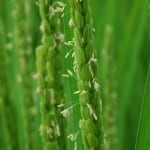 Summer in Japan this year was again hot, just about as hot as last year was. The warmer temperatures of the past decade and then some have continued. Furthermore, the islands of Japan were pummeled with typhoons this fall, meaning lots and lots of rain. Factoring in all that and more, the prognosis was that this year’s rice will be not dissolve very well; not too bad, mind you. Just not so well.
Summer in Japan this year was again hot, just about as hot as last year was. The warmer temperatures of the past decade and then some have continued. Furthermore, the islands of Japan were pummeled with typhoons this fall, meaning lots and lots of rain. Factoring in all that and more, the prognosis was that this year’s rice will be not dissolve very well; not too bad, mind you. Just not so well.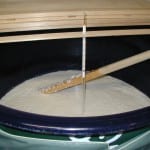 That’s the cool thing about sake: in making it, we can meet nature half-way. What will most noticeably suffer are the highest grades of sake, contest sake especially. But for most of us, what we will be drinking will be as good as it usually is; but we should not forget that added burden that will be on rice farmers and brewers to make it that way. Sake, like wine, remains an integral expression of nature.
That’s the cool thing about sake: in making it, we can meet nature half-way. What will most noticeably suffer are the highest grades of sake, contest sake especially. But for most of us, what we will be drinking will be as good as it usually is; but we should not forget that added burden that will be on rice farmers and brewers to make it that way. Sake, like wine, remains an integral expression of nature.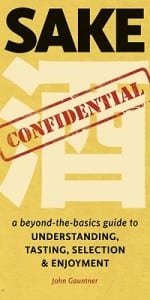
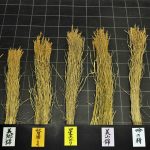 The main raw materials of sake are rice and water, and rice is the only fermentable material used in its production. And just as the grapes used to make good wine are significantly different from those bought at the supermarket, the rice used to make premium sake is significantly different from that which we find sitting under the fish in sushi, or in bowls in meals.
The main raw materials of sake are rice and water, and rice is the only fermentable material used in its production. And just as the grapes used to make good wine are significantly different from those bought at the supermarket, the rice used to make premium sake is significantly different from that which we find sitting under the fish in sushi, or in bowls in meals. In proper sake rice, the higher-than-normal starch content is mostly concentrated in the center of the grains. Why is this so heart-warmingly special? Because we want to get at the starch, which will be converted to sugar and then into alcohol. But we don’t want the fat and protein, which would lead to off-flavors and contribute rough elements to the sake. So with the starch neatly concentrated in the center, all we need to do is to mill away more and more of the outside of the grain, and by doing that we remove the fat and protein and leave only the starchy goodies behind.
In proper sake rice, the higher-than-normal starch content is mostly concentrated in the center of the grains. Why is this so heart-warmingly special? Because we want to get at the starch, which will be converted to sugar and then into alcohol. But we don’t want the fat and protein, which would lead to off-flavors and contribute rough elements to the sake. So with the starch neatly concentrated in the center, all we need to do is to mill away more and more of the outside of the grain, and by doing that we remove the fat and protein and leave only the starchy goodies behind.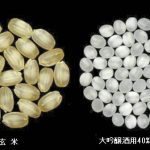 Why does sake rice have the starch in the center, and fat and protein around that? Part of it is just the nature of those strains. But it also has to do with climate and growing conditions. Regions with hot days and cold nights are best for sake rice production, as the cold nights coerce the plant to send the starch to the center of the grains. In “bad years” for rice, seasons being too hot or too cold, too wet or too dry, or when the night and day temperatures had less variance, fewer grains will have a decent shinpaku.
Why does sake rice have the starch in the center, and fat and protein around that? Part of it is just the nature of those strains. But it also has to do with climate and growing conditions. Regions with hot days and cold nights are best for sake rice production, as the cold nights coerce the plant to send the starch to the center of the grains. In “bad years” for rice, seasons being too hot or too cold, too wet or too dry, or when the night and day temperatures had less variance, fewer grains will have a decent shinpaku.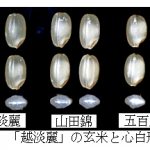 Note, too, that one can make decent-to-good sake from regular rice. It takes a good toji and good tools, but just a few of the many examples of table rice from which decent sake is brewed are Koshihikari, Sasanishiki, the illustrious Kame no O. So one can indeed make decent sake from table rice. It’s just easier to do so with real sake rice.
Note, too, that one can make decent-to-good sake from regular rice. It takes a good toji and good tools, but just a few of the many examples of table rice from which decent sake is brewed are Koshihikari, Sasanishiki, the illustrious Kame no O. So one can indeed make decent sake from table rice. It’s just easier to do so with real sake rice. The course will be held from the morning of Tuesday, January 10 to the evening of Saturday, January 14,2017, and will be focused in Tokyo, but with a two- day excursion to the Osaka – Kyoto – Kobe area to visit four sake breweries of various scale. Geared toward professionals, but open to anyone with an interest in sake, this course will begin with the basics, and will provide the environment for a focused, intense, and concerted training period. It will consist of classroom sessions on all things sake-related, followed by relevant tasting sessions, four sake brewery visits, and exposure to countless brands and styles in several settings, both in comparison to other sake, and with food. Participants will stay together at hotels in Tokyo and Osaka. Lectures will take place in a comfortable classroom, and evening meals will be off-site at various sake- related establishments.
The course will be held from the morning of Tuesday, January 10 to the evening of Saturday, January 14,2017, and will be focused in Tokyo, but with a two- day excursion to the Osaka – Kyoto – Kobe area to visit four sake breweries of various scale. Geared toward professionals, but open to anyone with an interest in sake, this course will begin with the basics, and will provide the environment for a focused, intense, and concerted training period. It will consist of classroom sessions on all things sake-related, followed by relevant tasting sessions, four sake brewery visits, and exposure to countless brands and styles in several settings, both in comparison to other sake, and with food. Participants will stay together at hotels in Tokyo and Osaka. Lectures will take place in a comfortable classroom, and evening meals will be off-site at various sake- related establishments. The cost for this five-day educational experience is ¥190,000. This includes all instruction and materials, as well as evening meals with plenty of sake each night. Other meals, transportation to and from as well as within Japan, and hotel are not included in the tuition. To make a reservation or if you have any questions at all, please send an email to John Gauntner at sakeguy@gol.com .
The cost for this five-day educational experience is ¥190,000. This includes all instruction and materials, as well as evening meals with plenty of sake each night. Other meals, transportation to and from as well as within Japan, and hotel are not included in the tuition. To make a reservation or if you have any questions at all, please send an email to John Gauntner at sakeguy@gol.com .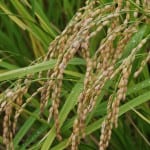 In the April issue of blog, archived
In the April issue of blog, archived 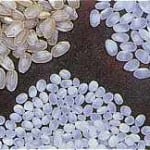 Before launching into its history and roots, let’s quickly review why it is significantly easier to make good sake using Yamada Nishiki. The grains are large, which means more potential for fermentable starch inside. The starches are concentrated in a ball of starch in the middle, and well centered, meaning it is easy to mill the outer fat and protein away, revealing only the starch. And, that protein and fat are at low levels to begin with, lowering the potential for off-flavors.
Before launching into its history and roots, let’s quickly review why it is significantly easier to make good sake using Yamada Nishiki. The grains are large, which means more potential for fermentable starch inside. The starches are concentrated in a ball of starch in the middle, and well centered, meaning it is easy to mill the outer fat and protein away, revealing only the starch. And, that protein and fat are at low levels to begin with, lowering the potential for off-flavors.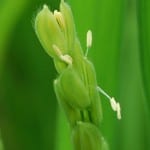 But after that change, tax was due in money based on the amount of land they owned. This means that all of a sudden rice was a commodity, a product to be sold on the marketplace that would lead to revenue to pay such taxes and cover living expenses and savings. As such, the more one grew the more one made, and farmers were all of a sudden very motivated to maximize yields and to do that by growing high-yield rice varieties. Sake rice varieties are decidedly not that kind of rice. So, even though demand for rice was increasing, the production of sake rice with its low yields began do prodigiously drop.
But after that change, tax was due in money based on the amount of land they owned. This means that all of a sudden rice was a commodity, a product to be sold on the marketplace that would lead to revenue to pay such taxes and cover living expenses and savings. As such, the more one grew the more one made, and farmers were all of a sudden very motivated to maximize yields and to do that by growing high-yield rice varieties. Sake rice varieties are decidedly not that kind of rice. So, even though demand for rice was increasing, the production of sake rice with its low yields began do prodigiously drop.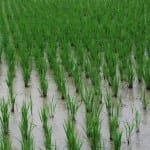 These are then grown to yield more seeds, which are then grown to yield even more seeds, that are then distributed to seed cooperatives, who then distribute the seeds to the farmers to use to grow the rice. So count ‘em: that is only three generations from purity each year, no seeds are any more than three generations from individually inspected and assessed purity. Dig that.
These are then grown to yield more seeds, which are then grown to yield even more seeds, that are then distributed to seed cooperatives, who then distribute the seeds to the farmers to use to grow the rice. So count ‘em: that is only three generations from purity each year, no seeds are any more than three generations from individually inspected and assessed purity. Dig that.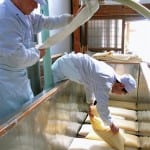 More information about the course, the schedule, the syllabus and the fun is available
More information about the course, the schedule, the syllabus and the fun is available 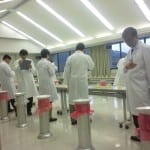 The government in Japan, in particular the National Tax Administration, monitors trends in sake preferences amongst consumers, as expressed by trends in sake production. The results of the analysis of data from last year’s sake was released a short while ago. While it is nothing shocking, it is interesting to see how things change. Here are a couple of tendencies culled from that slurry of data.
The government in Japan, in particular the National Tax Administration, monitors trends in sake preferences amongst consumers, as expressed by trends in sake production. The results of the analysis of data from last year’s sake was released a short while ago. While it is nothing shocking, it is interesting to see how things change. Here are a couple of tendencies culled from that slurry of data.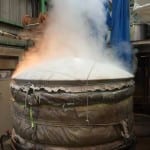 Again, hardly surprising, but the level of the ester ethyl caproate, which leads to aromas like ripe apple, tropical fruit and licorice or anise, has been on the increase. Curse it. This is hardly surprising considering that ginjo and daiginjo continue to grow very strongly in popularity.
Again, hardly surprising, but the level of the ester ethyl caproate, which leads to aromas like ripe apple, tropical fruit and licorice or anise, has been on the increase. Curse it. This is hardly surprising considering that ginjo and daiginjo continue to grow very strongly in popularity. Non-premium sake has seen a decrease in alcohol content overall. Ginjo et cetera has seen alcohol levels stay fairly high, likely for increased impact, but in non-premium futsuu-shu alcohol has dropped a bit on the average. I am not sure what the significance of this point is, though, nor was it elucidated upon in the government report.
Non-premium sake has seen a decrease in alcohol content overall. Ginjo et cetera has seen alcohol levels stay fairly high, likely for increased impact, but in non-premium futsuu-shu alcohol has dropped a bit on the average. I am not sure what the significance of this point is, though, nor was it elucidated upon in the government report.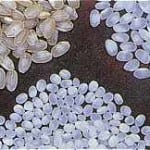 Milling
Milling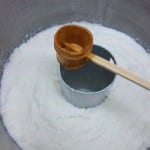 This section could be expanded to fill several books, at least. But since we do not have that luxury now, let us break it down a bit. There are three main ways of preparing the yeast starter, a few less mainstream but very valid ways, and tons of variations beyond that.
This section could be expanded to fill several books, at least. But since we do not have that luxury now, let us break it down a bit. There are three main ways of preparing the yeast starter, a few less mainstream but very valid ways, and tons of variations beyond that.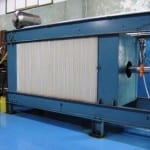 Machine press
Machine press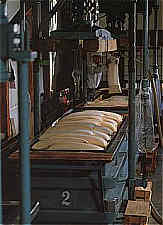 Fune (box press)
Fune (box press)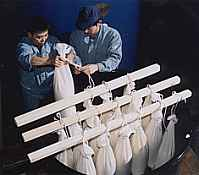 Shizuku
Shizuku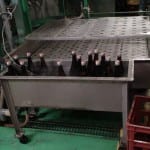 Pasteurization
Pasteurization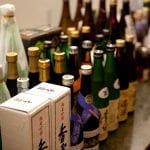 Fond of doing things at the last minute? Then check out the Sake Professional Course to be held in Toronto October 3, 4 and 5. Learn more
Fond of doing things at the last minute? Then check out the Sake Professional Course to be held in Toronto October 3, 4 and 5. Learn more 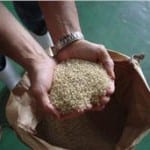 I. Rice = Flavor
I. Rice = Flavor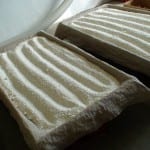 Koji provides enzymes that convert starch to sugar. Just how strong those enzymes are, and at what stage of the brewing process they are most active, will determine how sweet or dry the sake is. If the koji leads to lots of starch-to-sugar conversion early on, that sugar will be readily converted to alcohol leading to a dry sake. If sugar comes along later in the process when the yeast is petering out, it will remain in the sake and lead to sweetness. In truth, this too is more complicated. But therein lies the gist.
Koji provides enzymes that convert starch to sugar. Just how strong those enzymes are, and at what stage of the brewing process they are most active, will determine how sweet or dry the sake is. If the koji leads to lots of starch-to-sugar conversion early on, that sugar will be readily converted to alcohol leading to a dry sake. If sugar comes along later in the process when the yeast is petering out, it will remain in the sake and lead to sweetness. In truth, this too is more complicated. But therein lies the gist.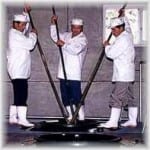
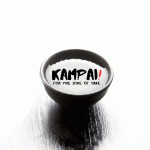 York
York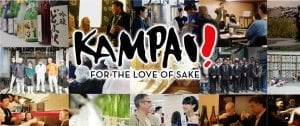 While it focuses on the paths of the three of us, a couple-few more people make appearances, including Haruo Matsuzaki, the “sake palate from you-know-where” industry consultant, and Daisuke Suzuki of Suzuki Shuzoten, brewers of Iwaki Kotobuki, who had to leave their kura in Fukushima due all that happened on March 11, 2011, are are now located in Yamagata.
While it focuses on the paths of the three of us, a couple-few more people make appearances, including Haruo Matsuzaki, the “sake palate from you-know-where” industry consultant, and Daisuke Suzuki of Suzuki Shuzoten, brewers of Iwaki Kotobuki, who had to leave their kura in Fukushima due all that happened on March 11, 2011, are are now located in Yamagata.